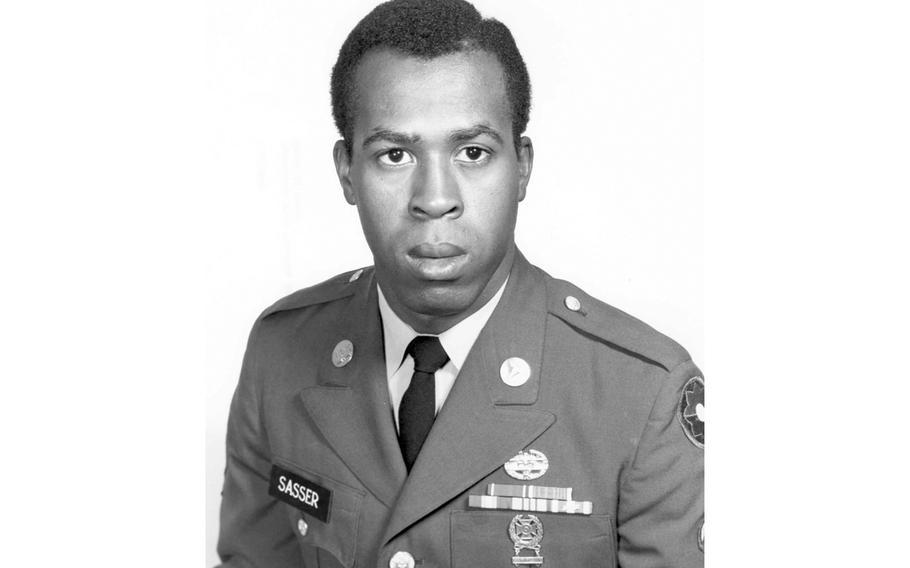
Army Spc. Clarence Sasser, who was presented the Medal of Honor in 1969. (Congressional Medal of Honor Society)
On the morning of Jan. 10, 1968, helicopters from an Army infantry company moved over the Mekong Delta on a reconnaissance sweep of a suspected guerrilla stronghold. Below, fighters allied with North Vietnam waited, hidden on the edges of rice paddies and under the jungle canopy.
When the helicopters were in range, the guerrillas opened fire with mortars, rockets and machine guns. One chopper was hit and went down. The pilots in the Company A convoy swooped low as the barrage intensified — coming from three sides — and touched down to pick up any survivors and return fire.
The American casualties quickly piled up. At least 30 U.S. personnel were killed or wounded in the first minutes of the attack. Pfc. Clarence Sasser, a medic, leaped off his chopper. Almost immediately, his leg was grazed by a bullet.
He raced across open ground to assist the injured. He brought one man to safety, splashing through the muck of rice paddies to reach a dike. An instant later, a rocket fragment tore into the shoulder of 20-year-old Pfc. Sasser.
“The pain sets in later,” recounted Mr. Sasser, who was presented the Medal of Honor for treating and rescuing more than a dozen others during a day-long ordeal even as he was bleeding from his own injuries. “The initial shock is what you experience, and the searing. Shell fragments are hot.”
Mr. Sasser, who died May 13 in Sugar Land, Tex., at 76, was drafted in 1967. He had been in South Vietnam for about four months when Company A was dispatched on the scouting patrol over the delta, where guerrilla forces known as Viet Cong had been increasing hit-and-run strikes.
An ambush awaited. “Fire all around us,” he recounted in a Library of Congress oral history project in 2001. “There wasn’t any choice. We had to go in.”
After bringing the first wounded serviceman to a protected area, Pfc. Sasser ignored his two wounds. He checked his medical supplies and ran back into the open. Suddenly, he collapsed. His legs were hit twice. He crawled to reach another injured soldier.
They all had to remain flat. “If you stood up, you were dead,” he said. “The snipers would get you.” He also knew that medics were special targets. Killing a medic, he said, probably meant that others would die on the battlefield because they couldn’t be treated. “It was the rationale,” he added.
The closest area with some protection, a cluster of trees, was about 200 meters away. He gathered a group of wounded soldiers. The only way out, he told them, was to cover the distance on their bellies. “It was a lot better than just laying here waiting on things to come in to kill you,” he recalled telling them.
In a line, with gunfire above them, they slithered over the rice fields. “The best way to get around that day was just simply grabbing the rice sprouts and sliding yourself along,” he said. “You could move better like that.”
They reached the trees, but the ground was soggy and filled with leeches that the soldiers constantly needed to pull off their skin. There was nowhere else to go, he said. Pfc. Sasser quickly used up all his medical supplies to stabilize who he could. Others were too far away to reach.
“The tough part wasn’t enemy fire, it was listening to guys call for their mama, and you can’t do anything. Listening to them beg all night,” he said in a podcast interview last year. “And then you don’t hear them anymore in the morning, so you know they died.”
During the night, U.S. airstrikes and napalm fireballs hit the guerrilla positions. Evacuation helicopters arrived just before dawn.
“Of course I was afraid,” he said. “But these were my guys. … My job was to take care of my guys. That’s it.”
‘Saving lives’
Clarence Eugene Sasser was born on Sept. 12, 1947, in Chenango, Tex., south of Houston, and raised on a farm in nearby Rosharon.
He enrolled at the University of Houston to study chemistry but needed a job to pay tuition. He moved to part-time studies, which ended his student draft deferment and opened him up to be picked for service.
Following his injuries in Vietnam, he was sent to a U.S. military hospital in Japan for recovery. He helped in the hospital’s dispensary and was assigned to remain. (In late January 1968, North Vietnamese forces launched the Tet Offensive in a major escalation of the ground war.)
He was presented the Medal of Honor on March 7, 1969, by President Richard M. Nixon at a White House ceremony that included the highly decorated World War II veteran, Audie Murphy. Mr. Sasser left military service three months later at the rank of specialist fifth class.
Mr. Sasser resumed his chemistry studies under a scholarship at Texas A&M University. He did not complete his courses — leaving to take a job at a petrochemical refinery near Houston — but was awarded an honorary doctor of letters degree by the university in 2014. A portrait of Mr. Sasser was placed in the Texas Capitol building in 2021.
His wife, the former Ethel Morant, was killed in a car accident in 1996. They had three sons. Complete information on survivors was not immediately available.
The death was announced by the Congressional Medal of Honor Society, which did not note a specific cause. There are 61 Medal of Honor recipients alive.
Mr. Sasser often expressed deep pride in his role as a combat medic, describing himself as part of a tradition of aid going back centuries. “My medal was awarded for saving lives rather than taking lives,” he said. “To me, it makes a difference.”